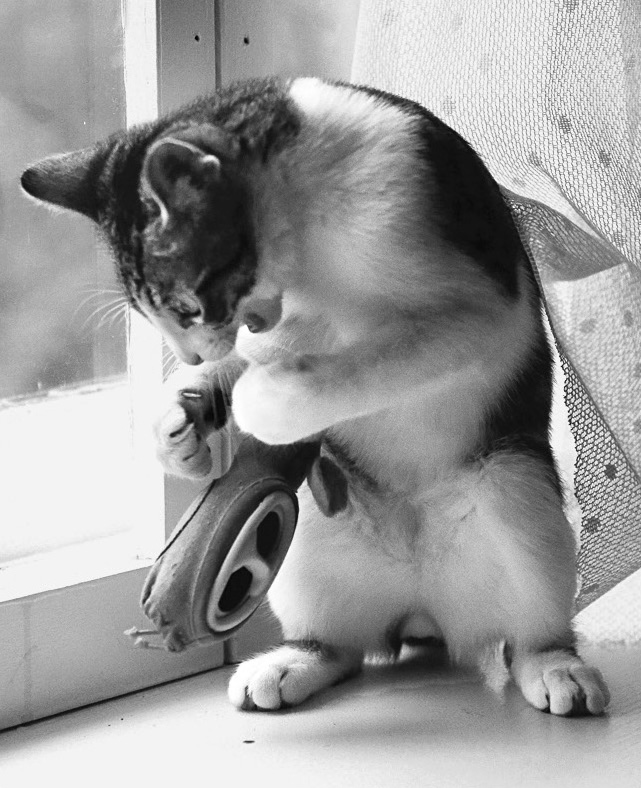
A young cat excitedly plays with the Indoor Hunting Feeder. She hunts for a portion of her daily food in a way that allows her to express her natural inclination to work for food.
Sarah Millet
Kelly Ballantyne, DVM, DACVB, and Amy L. Pike, DVM, DACVB
Jessica loved her new cat, Fiona. She was the most playful cat Jessica had ever had. Fiona greeted her at the door when she came home from work, and Fiona’s antics were usually very entertaining. However, Jessica wasn’t sleeping well because Fiona pounced on her and meowed repeatedly in the early morning hours.
Jessica had tried closing Fiona out of her bedroom, but the few nights she did so, Fiona meowed and scratched at the door most of the night. The only thing that seemed to stop the meowing was to feed Fiona, but it seemed like Fiona was waking her up earlier and earlier. Jessica was exhausted and not really sure what to do. While she loved Fiona, she was also really frustrated by some of her behaviors.
Unlike dogs, which humans actively domesticated, cats just came along for the ride. We encouraged cats to remain nearby as long as they controlled the rodents that threatened our food supply and homes. In return, we asked for very little change in their daily habits.
Fast-forward thousands of years, and instead of wandering outdoors, working hard to survive, our cats are now our indoor pride and joy. But with this new closeness comes a responsibility to remember what cats really are: active climbers, hunters, stalkers, and hiders. The inability to spend their days doing “cat stuff” and instead living in dull—or, worse, stressful or frightening—environments can take its toll.
Poor environmental conditions (too many pets; no safe places; lack of easy access to needs such as food, water, and litter boxes; nothing to do; lack of predictability) have been linked to stress, anxiety, obesity, and poor health. In this chapter, we will explore and explain the link between environment and medical health, and how certain medical conditions, such as feline interstitial cystitis (FIC), can be treated or prevented with environmental enrichment and stress-lowering techniques.
Enriched environments for cats should include safe and acceptable climbing, perching, and hiding areas; hunting excursions to find and procure their daily food; and soft bedding in safe places where they can sleep and dream. All these things strengthen a cat’s mind and body. This chapter will help you create a home where your cat will be fulfilled and enriched, and the envy of all her feline friends.
There is a long-held misconception that cats are low-maintenance pets. In other words, if you have a busy lifestyle, work long hours, or travel a lot, but want the companionship and joy of a pet, you should get a cat. Many people think all a cat needs is a home, a litter box, and bowls of food and water to be happy and thrive.
However, there is strong scientific evidence to the contrary. It shows that cats living without the benefits of an enriched environment are more prone to stress and anxiety, which can cause chronic diseases that may shorten their life span. These diseases also can lead to behavior problems that are frustrating to deal with—that may cause you to want to scream at your cat, confine her, or, worse, immediately take her to the shelter. Urine marking, using household areas as a bathroom, scratching your furniture, and aggression toward human and animal members of the household are common symptoms of stress.
Enrichment: Provisioning your cat’s environment so that it improves the quality and value of her life. Enrichment goes way beyond providing for a cat’s basic needs of shelter, food, water, and a litter box. It enhances the environment by giving your cat opportunities to express species-typical behaviors such as hunting, climbing, and playing in desirable, appropriate ways, and has a direct correlation with her well-being.
Stress: A state in which stimuli (stressors) have disrupted the optimum mental well-being of the animal. In this chapter, we will be talking about emotional stress. Stressors can be obvious (such as strangers in the home or a new cat housemate) or subtle (the owner leaves for work thirty minutes earlier, or the couch was moved to the other wall). Stress is closely related to anxiety.
Anxiety: A state of anticipation that is not necessarily about an actual stressor being present, but the worry about what might happen. The stressor can be real or imagined.
Sympathetic nervous system: The part of every mammal’s nervous system that is activated when the animal needs to react quickly. Known as the fight-or-flight system, the sympathetic nervous system is responsible for all the changes in the body when a cat is stressed. This stress response will not only suppress normal behaviors (such as playing, grooming, eating, sleeping, and social interaction), but it also can suppress the cat’s immune system, making her more prone to infections. Perpetual activation of the sympathetic nervous system can lead to chronic vomiting and allergic skin disease, as well as a cascade of changes associated with the bladder, known as feline interstitial cystitis.
Feline time budget: How a cat spends a typical twenty-four-hour period. Cats sleep on average about 40 percent of the day and spend another 22 percent resting—likely not a surprise to any cat owner. The hunting process (traveling, stalking, killing) takes up anywhere from 15 to 46 percent of their day, while eating their kill takes only 2 percent. Grooming takes up another 15 percent of the day.
Crepuscular: More active at dawn and dusk. Domestic cats are considered to be a crepuscular species.
Marking: An important form of communication in cats. Cats may mark their environment by bunting (rubbing their face on an object or animal), scratching, or urinating. Cats who urine mark typically spray urine on vertical surfaces while standing with their tail erect. Some cats will urine mark by depositing urine on horizontal surfaces. While urine marking is a normal form of communication in cats, those who urine mark frequently are often experiencing distress—such as having frequent conflicts with other cats in the home.
Pheromones: Species-specific chemicals released by several animals, including cats. These chemicals convey information to other animals of the same species. Cats deposit pheromones on objects in their environment when scent marking.
Sickness behaviors: A group of nonspecific medical and behavioral symptoms that can include a combination of any of the following: vomiting, diarrhea, decreased appetite or water intake, fever, enhanced painlike behaviors, decreased activity, decreased grooming, and a reduction in social interactions. Urinating and defecating outside the litter box can be considered sickness behaviors in cats. Sickness behaviors are believed to be a coping strategy to promote recovery. They are seen in response to both physical stressors (such as infections or other diseases) and psychological stressors (such as changes in the environment).
Feline interstitial cystitis (FIC): An inflammation of the bladder, with no known or identifiable cause (such as an infection), which can cause blood in the urine.
Cats can take care of themselves. We like to think of cats as independent animals, but, in fact, cats need our help to live safe and happy lives. Cats who spend 100 percent of their time indoors are entirely dependent on their human family members to provide them with an environment that meets their physical and mental needs. Cats who have outdoor access need our help to keep them safe and avoid outdoor perils such as vehicles, exposure to diseases, and harm inflicted by other animals or humans.
Cats are lazy. The image of a popular large orange cartoon cat may come to mind—an obese and lazy animal who sleeps and eats all day. This stereotypic image of cats misrepresents what cats actually are—active and agile predators. Remember, cats who fend for themselves can spend up to 46 percent of a twenty-four-hour period searching for food and hunting. Cats are opportunistic hunters and evolved to catch small rodents, such as mice. The size of their prey means cats need several small meals every day, and these meals may be few and far between. Cats need to be prepared to catch their prey whenever it appears, even after they have just eaten.
Your cat’s eyes and ears are attuned to the movement and noises of rodents. Once she detects potential prey, she will stalk it. Her body will be low to the ground, and she will wait nearly motionless in this crouched position, then suddenly pounce on the unsuspecting prey. This hunting style is very successful, with studies reporting only two to five pounces needed to capture prey, depending on the animal being hunted.
Cats learn hunting early in life, with lessons from mom beginning as early as four weeks of age. Young cats are particularly active hunters and may spend a large percentage of their time exploring and hunting.
Our mistaken view of cats as being lazy has probably developed from how we keep our cats. Indoors, cats have few options for entertainment. Inactivity is a result of their limited options, and they can quickly become uninterested and overweight. Once overweight, they may become even more inactive. A recent study comparing lean and overweight cats of similar ages found that the lean cats were significantly more active than their overweight counterparts and also interacted more with their caretakers.
Cats don’t care about human companionship. One recent study by Dr. Matilda Eriksson and her colleagues showed that cats interact for a longer time with their owners after extended periods of separation. This rebound effect of contact-seeking behavior after a prolonged absence demonstrates the importance of human companionship in a cat’s environment. Another study, by Dr. Kristyn Vitale Shreve and her colleagues, found that when given a choice, most cats will choose social interaction with humans over food. This is an interesting finding, considering that food is necessary for survival, and it highlights how important human companionship can be for cats. They benefit from positive and regular interactions with their owners, and a cat’s caregivers are actually the most important determinant of her mental and physical well-being.
Cats who live exclusively indoors require more time to interact with their owners compared with cats who have some outdoor access. We are their primary source of entertainment! Although cats benefit from social interaction, they also need time to be alone to rest and avoid conflicts. So while it’s important for you to interact with your cat regularly, it’s equally important to provide her with a space that she can retreat to when she needs time to herself.
Jessica realized that she needed help with Fiona and scheduled a behavioral consultation. During the consultation, we determined that while Jessica provided Fiona with food, water, and a litter box, the cat lacked the enrichment she needed to entertain herself and be a cat while Jessica was at work. Jessica was Fiona’s only real source of entertainment, and Fiona was bored!
Enriching your feline’s environment can seem overwhelming—for you and for her. Abrupt change is hard for everyone, but it can be especially problematic for our sensitive cats. We recommend making incremental changes over the course of several weeks to months. Implementing one new thing every few days or weeks will cut down on the stress that the novelty itself can cause.
There are four areas of enrichment to address: cognitive, physical, sensory, and social. Cognitive enrichment focuses on mental stimulation and encourages your cat to think about and puzzle through a problem or task. Physical enrichment focuses on the structure and layout of her environment. Sensory enrichment focuses on the five senses: taste, sight, smell, hearing, and touch. Social enrichment focuses on your cat’s interactions with you, other cats in the household, and any other pets you may have. Each kind of enrichment we discuss here can address one or several of these areas.
As we know from the feline time budget (see “What Does That Mean?” earlier in this chapter), about one-third to one-half of your cat’s day is spent acquiring and eating food. If you feed your house cat one or two meals out of a bowl, it likely takes her no more than ten minutes to eat, which is less than 1 percent of her day. So how should she fill the rest of her time? Perhaps by munching on your houseplants or finding a hair tie in the bathroom to chew on, leading to a visit to your veterinarian’s office. Or maybe just by sleeping more, which can further contribute to inactivity and obesity.
Her wild feline counterpart eats ten to twenty small prey each day, and up to half of her hunting trips are unsuccessful. One easy way to extend the time your cat takes to find and eat her meals is to place her food in food-dispensing toys. These toys deliver food only when your cat plays and interacts with them. So instead of imitating the vacuum cleaner at mealtimes, she can show off her inner hunter.
Introduce each food-dispensing toy by placing your cat’s favorite treats inside. Place the toy in the spot where you normally feed her right before her normal mealtime, so she is especially hungry. Put a couple of treats next to the toy to pique her interest in it. Some cats like to imitate their owners, so you might want to play with the toy to show her how it dispenses the food.
Your cat’s interest in her regular diet and how savvy she is with the new toys will determine how quickly you can switch her completely from eating out of a bowl. Once she is comfortable eating solely out of the toys, the next step is to start moving the toys to various locations throughout your home. When she has mastered several toys, you can vary which ones you put out each day, so that she can hunt and eat in different ways throughout the day and night.
Since she is crepuscular, it would be ideal to have food-dispensing toys available at dawn and dusk, when she is likely to be more active. To avoid any thieving canine housemates, place feeder toys on elevated surfaces or only in rooms that are inaccessible to your dogs (because of baby gates or microchip-activated cat doors).
We determined that not only did Fiona need more entertainment, but she also needed a change in feeding routine, as she had learned that the best way to get food was to pounce on or meow at Jessica. To address both issues, one of the first things we introduced into Fiona’s home was food-dispensing toys. Once Jessica was sure Fiona was eating out of the toys, she began a new routine of hiding a few of these toys around the house before she left for work, as well as hiding a few around the house before bedtime. When she started this new routine, Jessica was also careful never to feed Fiona when she was meowing.
Some of our favorite commercially made food-dispensing toys include the Trixie 5-in-1 Activity Center, the Indoor Hunting Feeder from Doc & Phoebe’s Cat Co., PetSafe’s SlimCat and Egg-Cercizer, the Pipolino, and Kong’s Cat Wobbler. You can also make your own toys using materials found around the house, like empty cardboard paper towel or toilet paper rolls, tissue boxes, plastic yogurt or cottage cheese containers, egg cartons, or ice cube trays. (See “The Three-Minute Food-Dispensing Toy” in chapter 11.)

A young cat excitedly plays with the Indoor Hunting Feeder. She hunts for a portion of her daily food in a way that allows her to express her natural inclination to work for food.
Sarah Millet
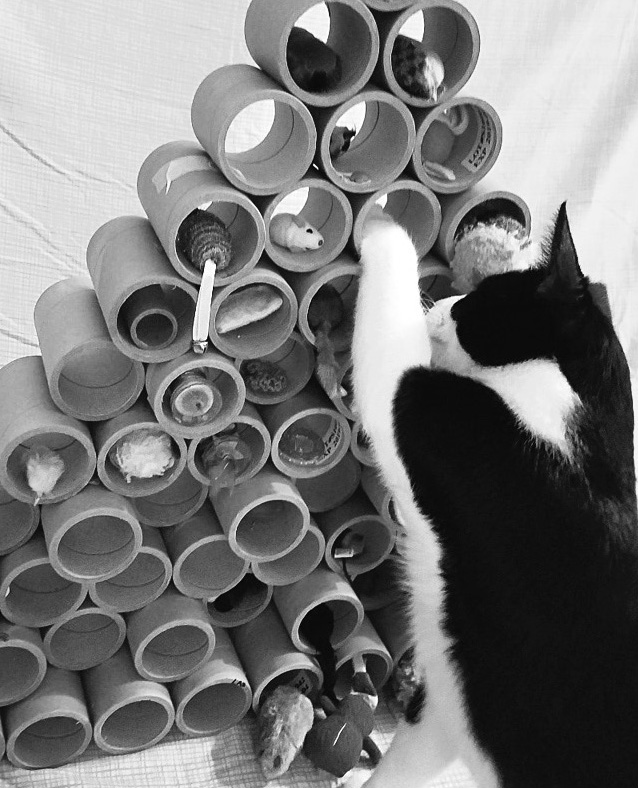
A homemade tower of toys and treats can provide hours of investigative fun for your cat. Tino’s tower is made from cardboard tubing.
Deborah Crosier
Another way to make feeding time more enriching is to vary the type of food you give your cat. Cats develop food preferences as young kittens, so to increase the chances that your cat will accept different types of food later in life (for example, if your veterinarian prescribes a diet change), it is important to introduce a variety of food types, brands, and flavors early on. This includes dry and canned, different meats, pâtés and chunky stews, and various kibble shapes.
It is also important to remember that you do not want to frustrate your cat by introducing enrichment that is too difficult for her skill level. This is especially true with food-dispensing toys. It can be very dangerous for cats to go several days without eating, so when you try a new food toy, make sure your cat is getting enough food out of the toy or is getting supplemental meals as needed.
Your cat’s safe place is a private area that allows her to retreat and feel protected; it gives her a sense of security and control. Put one safe place up high—your cat will want to climb up to observe her home, especially when there’s been a change (such as a visitor arriving) or when she’s frightened. Provide her with a few different options, including an open resting spot such as a shelf or windowsill and an enclosed resting spot such as a box or bed with high sides. You can encourage your cat to use these spaces by lining them with washable fleece bedding to make them extra comfy.
While the carrier can be a good option for a safe hiding place, your cat may have learned to fear her carrier if you have only brought it out before frightening experiences, such as going to the veterinarian or riding in the car. To improve the way your cat feels about her carrier, make it a normal feature of her environment.
Set it in an area that she uses frequently and leave it there. You may find that she will use it more often if you put it on an elevated and stable surface, such as a shelf. Encourage her to explore the carrier by hiding food or catnip inside, and line the bottom with comfortable bedding so that she can curl up for a catnap.
Turning your cat’s carrier into a safe space will not only give her a great option for resting when indoors, but it can also offer her comfort and a sense of familiarity when traveling or taking trips to the veterinarian. This is especially important for cats with chronic illnesses, who may need to make several trips to the veterinary clinic every year. (See appendix A for more tips about carrier training.)
Safe spaces are especially important in multicat homes. While many cats can tolerate living in homes with other cats, they’re most successful when they have enough space to keep their distance from one another and get out of sight when needed. A study by Dr. Sharon Crowell-Davis, DACVB, that evaluated the habits of indoor cats found that most cats prefer to maintain a distance of at least three to nine feet when they are within sight of one another, and they may spend as much as 50 percent of their time out of one another’s sight.
You can help your cats avoid social stress caused by too much contact with their housemates by providing as many safe places in the home as you have cats. Even if you live in a small house or apartment, you can increase the amount of vertical space for your cats by adding perches, shelves, and cat trees. You can also divide rooms into several sections using vertical room dividers. These dividers make rooms more complex and give your cats more choices about where they want to be—and whom they want to see.
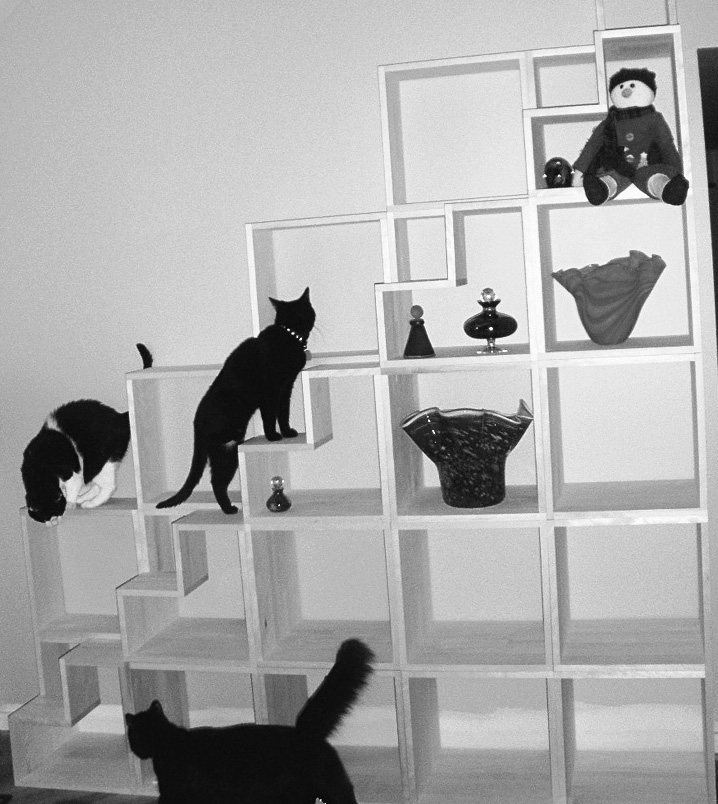
The “cat library” is a concept started by a few creative architects with an interest in feline furniture. Hobbes and his housemates enjoy the increased vertical space and hiding spots this homemade version provides.
Anne Gallutia
Although cats are a social species, they can be quite possessive of their space and resources, especially with other cats they were not raised with or are not directly related to. We cat owners choose which cats will live in our household—the choice is not theirs. This is like your college picking your dormitory roommate; you may not necessarily like the person they pick!
In a household with multiple cats, it is important to create a separate core area for each cat. This is a specific area within the cat’s territory (the space the cat actively uses and defends) where you should put all the resources she needs. Observe where each cat tends to hang out when left to her own devices, and choose the location of the core area accordingly. That area should include the cat’s food, water, litter boxes, toys, resting places, perching and hiding spots, and enrichment opportunities. Two cats who spend all their time together may share their core areas.
Having an environment of plenty that offers each cat a separate space for her wants and needs will help alleviate tension among your cats and also help prevent, and sometimes eliminate, fighting, urination and defecation outside the litter box, and episodes of feline interstitial cystitis.

Junebug enjoys her own core area, where she has access to food, water, scratching options, and toys in an upstairs bathroom. Her housemate has a separate and similar area downstairs.
Meghan E. Herron
Cats benefit from regular, positive, and consistent interactions with their human family members. In fact, a cat’s human family is likely the most important determinant of her mental and physical well-being.
During our discussion with Jessica, she mentioned that she had never been able to create a consistent routine with Fiona. She loved talking to, petting, and playing with Fiona, but her work schedule was demanding. She found that more and more she rarely had the energy to interact with Fiona during the week. She felt very guilty about this and ended up trying to give Fiona lots of attention on the weekend.
Jessica is not alone. Many pet owners balancing the demands of jobs, family responsibilities, social lives, and caring for their pets feel stretched thin. It’s tempting to just meet your cat’s basic needs of providing food, water, and litter box care during the workweek, then focus on play and interaction on your days off, when you have more time. However, a study by Dr. Judi Stella and her colleagues showed that a simple change in routine (like skipping daily playtime or varying mealtimes) can result in sickness behaviors such as decreased appetite and vomiting, as well as house soiling. These findings highlight the importance of keeping a consistent routine for feeding, playtime, and interaction with your cat. Since she has little control over her environment, a regular schedule will provide predictability and reduce stress.
Rather than trying to interact with your cat a lot on just a couple of days a week, set up a regular schedule for playtime and interaction every day. It helps to time this around other daily activities, such as mealtimes, so it becomes a habit for both of you. A little can go a long way—just two to three minutes of daily playtime can be a positive addition to your cat’s daily routine. And if you want to add more mental enrichment, try positive reinforcement training (see chapter 6).
Keeping a consistent routine for interactions is an important aspect of cat care. However, change is part of life, so when you need to make a change in your schedule, do it gradually so your cat has time to get used to the new routine.
How you interact with your cat is as important as how regularly you interact. Cats experience less stress when they’re allowed to choose whether to interact or not rather than having interactions forced on them.
While Jessica was tempted to cuddle with Fiona frequently on weekends, she admitted that this often happened when the cat was napping, and Fiona occasionally hissed and swatted at her when she was trying to show Fiona affection. A simple switch to inviting Fiona to interact with her and not disturbing her during her naps resolved the swatting and hissing. Jessica was also careful to respect Fiona’s limits, so when the cat moved away during a cuddle session, Jessica didn’t force the issue by following her or picking her up.
Each cat is an individual when it comes to the types of toys she enjoys playing with. Yours may prefer chasing the laser pointer, swatting a ball around a track, attacking a feather attached to a fishing pole, or chasing a remote-controlled mouse through the living room. There are also motion-activated toys that turn on when she walks in front of the sensor, and ones that can be set to move around at certain time intervals, which can be very useful if your cat is home alone for long periods of time.
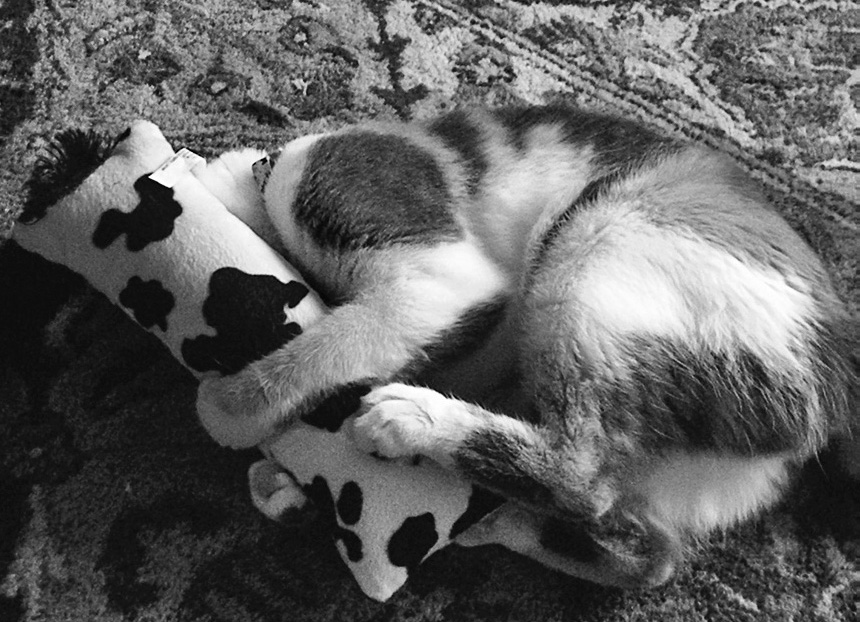
Sophie grabs, bites, and kicks at her Kong Kickeroo, mimicking a normal predatory behavior.
Amy L. Flom
Toys and playtime should mimic hunting opportunities for your cat and include stalking, chasing, and capturing. Be aware that some cats may get frustrated by laser pointers because, since the cat can’t capture the light, she is unable to complete the full hunting sequence. It is best to end laser pointer play by landing on a treat or toy that she can actually attack and so feel fully satisfied.
Cats depend much more on their nose than we do. Your cat’s sense of smell provides her with important information—helping her to detect potential threats as well as giving her a sense of familiarity and security. She deposits pheromones around your home by scent marking—both rubbing on and scratching objects. These pheromones are used to communicate with other cats and to establish her core living area.
Whenever possible, it’s important not to interfere with your cat’s sense of smell. Don’t use strong cleaners and detergents around your home, and always use unscented litter in her litter box. You also need to provide your cat with scratching posts, pads, and boxes where she can deposit her scent. Ideal locations for scratching surfaces are near entryways and your cat’s resting areas, as these are places where she will naturally want to deposit her scent by scratching and rubbing. Providing her with appropriate scratching options may help prevent her from scratching on furniture.
One of the best types of scent enrichment is catnip, which comes from the perennial herb Nepeta cataria, a member of the mint family. Only 50 to 60 percent of cats actually respond to catnip, and there is a genetic basis for this trait. Although most responder cats become lovable and relaxed when exposed to catnip, some become reactive and aroused. The first time you offer catnip to your cat, make sure she is in a room by herself, away from other pets and small children in the household, so you can see what her response is.
Many cats enjoy playing with toys that contain catnip, or simply just rolling around in some freshly crushed catnip strewn on the floor. As with cooking herbs and spices, catnip loses its aroma over time, so you should periodically refill or replace any catnip toys to increase their desirability.
Chewing on edible plants such as mint, parsley, or cat grass is another kind of enrichment that satisfies a cat’s senses of taste and touch. Cat grass is grown from a variety of nontoxic grass seeds, including barley, oat, wheat, and rye, and can be a great alternative for cats who enjoy munching on your houseplants, many of which are toxic to cats. To make sure the plants in your house are not toxic, visit the ASPCA’s plant database at www.aspca.org/pet-care/animal-poison-control/toxic-and-non-toxic-plants.
Cat-specific music can be a good form of auditory enrichment. Music for cats is specifically composed and played at frequencies, tones, pitches, octaves, and tempos that your cat will enjoy. The types of music that cats like are even supported by research! There are tunes created to help them relax and those that can stimulate them, which are good at playtime and feeding time. Two sources for such music are Music for Cats (www.musicforcats.com) and Through a Cat’s Ear, a CD/MP3 series available from various outlets.
Many cats enjoy watching birds from their window perches, so placing a bird feeder in the yard or near the window can increase your cat’s enjoyment. Watch her after installing the feeder to make sure she isn’t bothered by the sight of prey without having the opportunity to chase it. If she appears nervous or frustrated while watching birds from the window, remove the feeder. And, of course, if your cat goes outside, then luring birds to your house is not a good idea.
Your cat may also enjoy watching fish in a fish tank or turtles in a terrarium, but make sure the top of the tank is closed so she doesn’t inadvertently fall in or make one of them a meal.
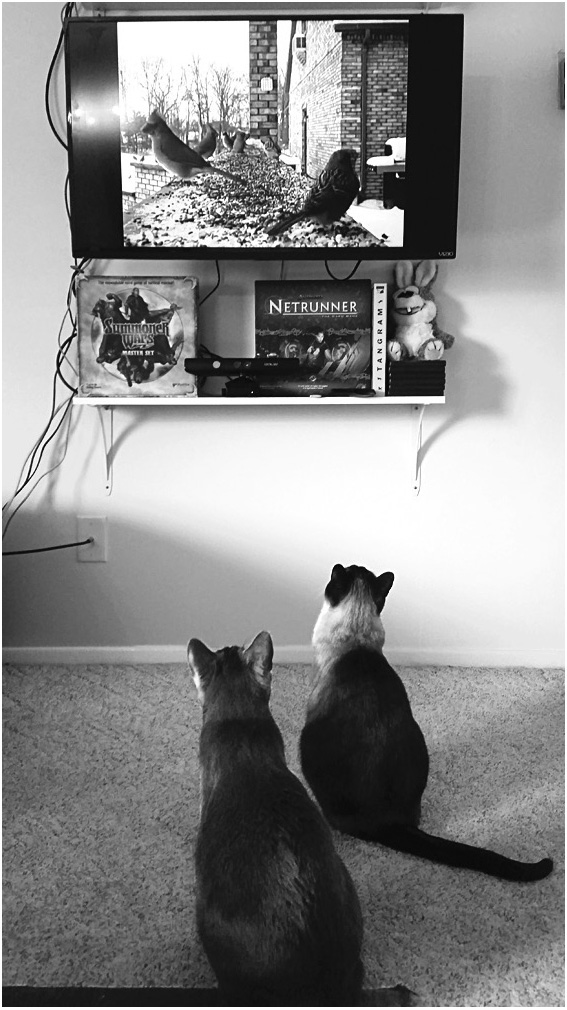
Smokey Joe and his best friend. Peanut, are captivated by a movie made for cats, with birds and other prey animals moving around the screen.
Brittany Vance
There are several high-tech ways to visually stimulate your cat, including games and apps for your phone or computer that mimic bugs and prey for her to swat at. These can be both fun for her and entertaining for you! Just as with laser pointers, if your cat becomes frustrated by not being able to capture the “prey,” avoid these visual activities, which will likely be more detrimental than enriching.
While keeping your cat exclusively indoors can protect her from many dangers, such as vehicles, diseases, fights with other cats, malicious humans, and predation by larger animals—as well as protect sensitive wildlife populations such as migrating songbirds—it also limits variety in her environment and can result in boredom and behavior problems.
If you want to allow your cat outdoors, make sure she is microchipped for identification, properly vaccinated against contagious diseases, and protected from both internal and external parasites, such as fleas, ticks, and mosquitoes. If your cat doesn’t have access to the outdoors, she should at least have access to natural lighting and a window where she can look outside. If you have more than one cat, make sure there are perches by several windows to limit competition for this valuable resource.
You can make going outdoors safer for your cat and for the local wildlife by creating a secure screened-in enclosure in your yard or on your deck—a catio! Another option is to enclose your yard with cat-proof fencing, which can give your cat access to your entire yard while preventing her from getting out (and other animals from getting in). Even with adequate fencing or an enclosure, cats should not be allowed outdoors without your supervision, because of the risks of potential escape and other animals entering the space.
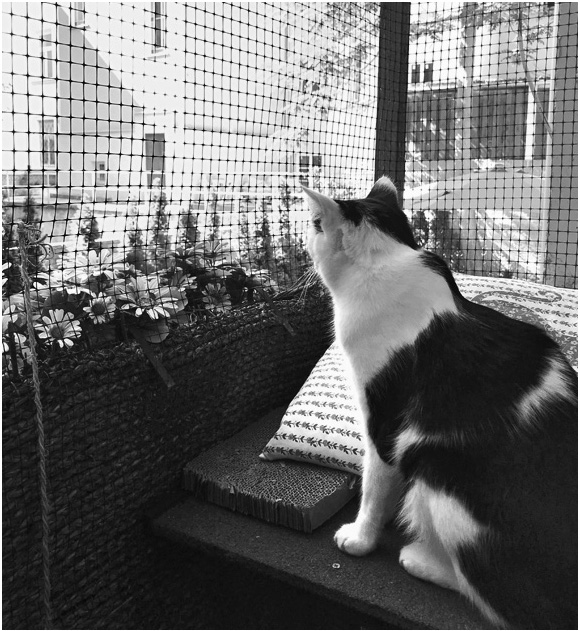
Spotty enjoys the safe outdoor view from her catio.
Kelly Ballantyne
Although you may view giving your cat access to the outdoors as a special treat, if she has had limited experience outside, she may become overwhelmed and frightened. Watch her body language carefully for signs of fear, and provide her with elevated perches and enclosed areas to hide in, just as you do indoors.
Depending on your cat’s temperament and experience with the outdoors, you can train her to wear a harness and leash so you can take her on a walk around the neighborhood. Due to the risk of entanglement, cats should always be supervised when on leash.
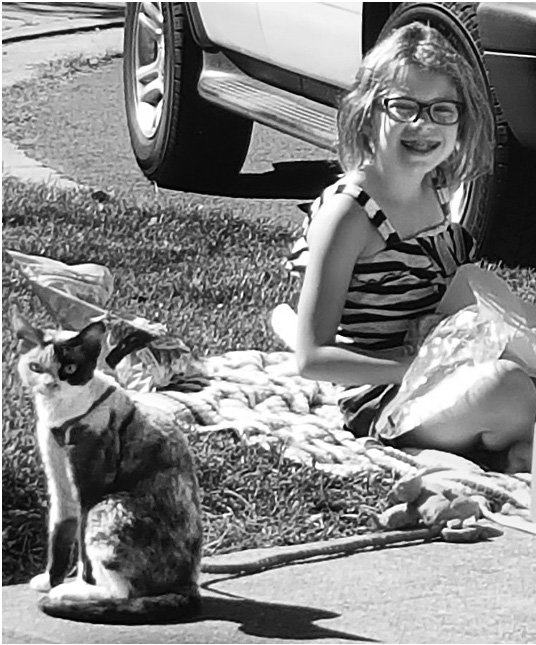
Dobby enjoys a little outdoor time with his big sister, safely restrained by his kitty harness and leash.
Amy L. Pike
Jessica lived in a third-floor apartment that did not have a balcony. While she had plenty of windows, Fiona could not access any of them. The windowsills were narrow, and there were no nearby perches or shelves where Fiona could rest and observe the outdoors. Despite these initial challenges, we came up with several options to provide Fiona with this important source of enrichment, including setting a low side table below one window and installing window perches near a few others. Within a few weeks, Jessica reported that Fiona was spending much of her time on these window perches, and they appeared to be her new favorite resting spots.
Some cats enjoy being groomed and petted, which can be another form of tactile enrichment. If you watch cats grooming each other, they focus on the head and neck areas, so it is a good idea to concentrate your petting and grooming on those areas—especially if your cat is not that fond of being petted in the first place. A recent study by Dr. Sarah Ellis and Dr. Helen Zulch found that petting the back half of a cat produces more negative reactions than petting the front half.
Food and human interaction are typically the forms of enrichment cats prefer most. However, providing your cat with one-on-one social enrichment can be difficult, depending on your schedule. Make sure you carve out time to spend with her that is purposeful and meaningful for both of you.
Many of the activities discussed in this chapter are intended for you and your cat to do together and will provide enrichment to both your lives. If your cat likes the company of other people, having friends come by to interact with her, especially when you are away for long periods, can give her some much-needed social interaction and perhaps satisfy a need for those friends who want some cat snuggles.
My cat won’t play with food-dispensing toys. Introducing food-dispensing toys to a cat who has never had to do anything other than scarf down her food can be challenging for both you and her. It’s important to take your feline’s current skill level into account when introducing food-dispensing toys and never offer anything that may be frustrating for her. To encourage a toy’s use, take it apart and place treats around and inside it to lure your cat over. Some cats will even play with the toy if they see you doing so.
If your cat likes to bat toys around, consider food-dispensing toys that require her to use her paws to get the food. If she’s more of a couch potato, stationary food toys may be more up her alley. Increase her motivation to interact with the toy by introducing it when you know she will be hungry, and initially use high-value treats instead of her regular kibble to entice her to use it.
Gradually reduce the amount of food in your cat’s bowl each time she readily eats out of a food toy. Start with about a quarter of her daily ration in one or more toys, and every few days increase that proportion. Once she is fully comfortable playing with the toys to retrieve her food, eliminate the bowl entirely. You should still keep track of her daily intake, though, because a change in food consumption is an indication of an illness.
I set up a perch for my cat, but she won’t use it. While most cats prefer a safe spot that is several feet off the floor, some cats may not be able to reach elevated resting areas because of their age or reduced physical capabilities. If you have a kitten or an elderly cat, if your cat has arthritis, or if your cat is overweight, she may need assistance getting up to her preferred perch. Provide ramps, pet steps, or a series of perches spaced at strategic intervals to help give her access to her safe space without much jumping.
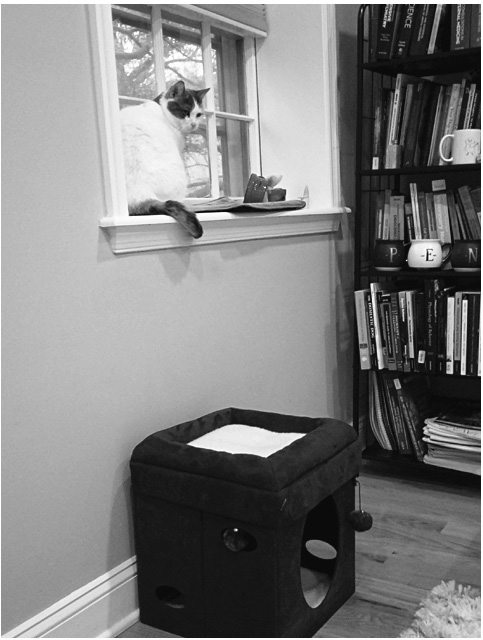
Elsa loves watching the birds perched on the tree outside her window. This strategically placed cat cubby gives her the boost she needs to reach her favorite spot.
Carlo Siracusa
I gave my cat scratching posts, but she is still scratching my furniture. Your cat’s failure to use the scratching surface you’ve provided could be related to a variety of factors, including the type of surface, the location of the surface, and whether it is vertical or horizontal. Most cats prefer surfaces covered with wood bark, cardboard, or sisal rope for scratching, but some may prefer carpeting or fabric. Offer a few different options, both vertical and horizontal, and make sure you place them in key areas around the house that your cat visits often.
If you have a vertical scratching post, make sure it is tall enough for your cat to stand up on her back legs to scratch. Whether vertical or horizontal, the scratching surface must be stable and not slip or wobble, as that may scare your cat. And if your cat appears to have a particular penchant for scratching your favorite couch, try covering a scratching post with a similar fabric.
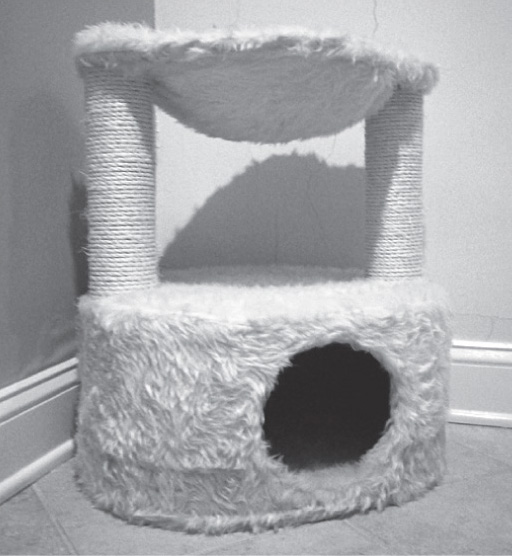
This scratching post offers two vertical scratching options close to resting places.
Carlo Siracusa
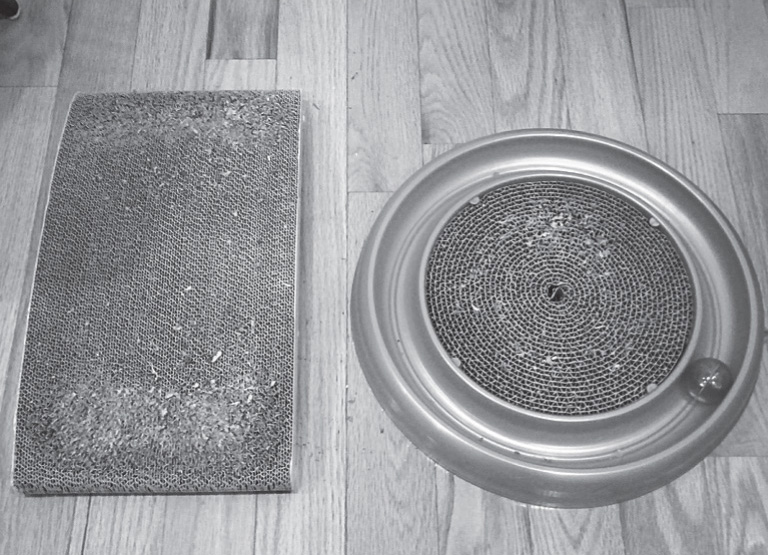
Both of these horizontal scratchers have rubber bottoms to prevent slipping during scratching.
Carlo Siracusa
To encourage your cat to investigate her designated scratching area, rub catnip on it and reward her with a small treat whenever you see her using it.
A newly available treatment for unwanted scratching involves applying a synthetic feline interdigital pheromone (Feliscratch by Feliway) to your cat’s scratching post. This product leaves a visual mark (blue dye) in addition to the pheromone, mimicking the visual and scent marks created when cats scratch, thus encouraging your cat to scratch in desirable locations. A recent study testing this product over twenty-eight days showed it was effective in decreasing unwanted scratching in house cats.
Cats will lose interest in toys and other enrichment items that are simply left out all the time. There are so many new enrichment items that hit the market daily that you could likely buy a new one every single day of your cat’s life. That could get rather expensive. So unless you want to spend as much on these items as on a college education, try rotating her toys as a way of introducing novelty. Put a few away when she appears to have lost interest in them and bring out a few to replace them. And voilà, what once was old is new again!
Homemade toys can also be very effective in stimulating play. Dr. Sagi Denenberg, DACVB, studied cats’ preferences for several different types of toys and found that most of the cats preferred to play with one simple homemade toy—a hair band tied to a string—more than all the others, including store-bought items such as plastic balls or feathers on a stick. You may find that your cat likes playing with similar toys or other common household objects, such as plastic bottle rings or wadded-up paper balls. Just make sure you put away toys with strings or other easily ingested objects between play sessions.
If you already know your cat gets along well with other cats, and you have the time, money, and space to open up your home to another feline friend, she may enjoy having a buddy. Sometimes a full-time roommate can be the best enrichment of all.
When adopting another feline friend, make sure you set up a separate core area for her. Use this area initially to separate the newcomer from your current cat, then turn it into her own special space to retreat to once they are integrated. (See chapter 5 for how to do proper introductions.) You should be able to completely close off the new area from the other cat with a door or multiple baby gates stacked on top of each other to prevent escape. It is important to make this core area an environment of plenty, with food, water, litter boxes, hiding spots, her favorite toys, and the other enrichment resources discussed in this chapter.
Now that your cat has a buddy, don’t forget to continue playing with and paying individual attention to both her and her new friend. Remember, cats do not like to share resources, including attention from their owners!
Jessica gradually made many of the changes discussed throughout this chapter to enrich the home she shared with Fiona. After a few months of living in this feline dream home, Fiona was playing with her food-dispensing toys, enjoying her daily play sessions with Jessica, and no longer pouncing on or meowing at Jessica in the middle of the night. Jessica was sleeping better and felt that her bond with Fiona was stronger than ever.
As Jessica found out, enriching your feline friend’s world is one of the most important strategies to prevent stress and promote good health. Making simple changes in the way you feed her, providing her with safe places to retreat to and rest, increasing the consistency and number of times you play with and groom her, and stimulating all five of her senses can give her the kind of environment that will make her the envy of all the other felines in your neighborhood. She will truly be the cat’s meow.
An enriched environment is key to your cat’s well-being, health, and happiness.
Enrichment means providing an environment of plenty, with outlets for all her species-typical behaviors of playing, hunting, and climbing.
Options for enrichment include safe outdoor access, toys, food-dispensing toys, nontoxic edible plants and catnip, cat-specific music and movies, the companionship of a buddy, and much more.
Human companionship is an essential source of feline enrichment. To decrease stress and increase predictability, make time for daily play and interactions.